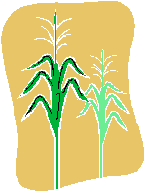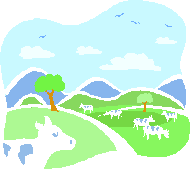

To send a message to an author, click on the author's name at the end of the article.
This Month in Ag Connection | Ag Connection - Other Issues Online
If you purchased crop insurance on your 2011 wheat crop, you probably noticed some changes. Risk Management Agency has been working on the changes for quite some time and finally those changes begin with 2011 crops.

The Risk Management Agency has released the Common Crop Insurance Policy (CCIP) or what is now being commonly called the Combo policy. The purpose for making changes was to simplify the crop insurance choices with one product the Combo policy. This Combo policy combines existing insurance products (Actual Production History (APH), Crop Revenue Coverage (CRC), Revenue Assurance (RA) and Income Protection (IP)) into one policy.
The combo policy applies to the major crops in Central Missouri including corn, grain sorghum, soybeans, wheat, as well as many other crops.
These changes will not affect the existing group plans (Group Risk Plan (GRP) and Group Risk Income Plan (GRIP)) since those products are not individually based.
How does it work? The Combo policy allows farmers to choose one of three coverage options: 1) yield, 2) revenue or 3) revenue with harvest price exclusion. These options should sound very familiar to the existing crop insurance products.
1. Yield Protection Policy – replaces APH policies. This policy will pay when yields fall below a yield guarantee.
2. Revenue Protection Policy – replaces CRC & RA with harvest price option. This policy will pay when revenue is below a revenue guarantee. The guarantee can increase if the harvest price is above the projected price.
3. Revenue Protection with Harvest Price Exclusion Policy – replaces RA with base price option and IP. This policy will pay when revenue falls below a guarantee. With the harvest price exclusion, the guarantee will not increase if the harvest price is above the projected price.
The new changes will have some benefits. There will now be one set of crop provisions, one set of actuarial documents and provide more uniformity in policy acceptance requirements, premium calculations and price discovery.
If you have a carryover policy it will automatically be converted to the plan closest to your current coverage and no new application will be required.
It would definitely be a good idea to contact your insurance agent just a little early to make sure you get the product you want and to ask questions.
Source: Mary Sobba, MU Extension Agriculture Business Specialist
This Month in Ag Connection | Ag Connection - Other Issues Online
Over the last few years, high fertilizer prices combined with wet falls and late harvest have resulted in many fields not receiving all of the phosphorous (P) and potassium (K) needed to maintain optimum test levels. However, this fall looks promising for P and K applications with the early harvest and drying soil conditions. With current grain prices, the return on fertility investment may be greater than when grain prices were lower.
How should the P and K fertilizer be placed? Some placement possibilities are; incorporation in the soil with tillage, left on the surface, banded on the surface, or banded deep (4-8 inches) below the surface. However, University research from the Midwest indicates that how you apply P and K does not matter. What is important is that you apply it or that you confirm that test levels are adequate for crop production. Deep banding is sometimes suggested because it makes the nutrient more available but, the only time researchers have seen an advantage to deep placement is when soil test levels are low.

What about annual versus biennial applications? University research indicates that as long as the needed fertilizer to make sure soil tests levels are adequate to supply what the crops need, no yield benefit hinges on whether the application is done every year or every other year. Biennial application will result in saving time and making one less pass over the field. Research has shown that with biennial applications it is better to apply fertilizer before the corn crop and to have soybean as a residual feeder. If your soil test does not build up, annual applications may result in better soil test levels.
Is it better to apply P and K in fall or spring? Many studies indicate that as far as providing nutrients to the crop; neither spring or fall applications is better at increasing nutrient availability. Fall application provides the advantage of more time and equipment available than the spring planting season. Soil compaction is usually less of concern in the fall and tillage operations are more feasible in the fall. One potential drawback for fall application is the fact that the nitrogen (N) accompanying P in MAP and DAP is more susceptible to loss even if applied in the fall. The benefits of a fall application typically can outweigh the potential for any small N losses.
It should be noted that if you are following corn with corn; corn can remove more P and less K than soybeans. Therefore, your fertilization plans should be adjusted accordingly to your cropping situation.
Source: Wayne Crook, MU Extension Agronomy Specialist
This Month in Ag Connection | Ag Connection - Other Issues Online
Fall is a time for beef producers to assess the past growing season and prepare for the upcoming winter months. Evaluating the forage base and livestock performance can help identify changes that need to be made in upcoming growing seasons.
1. Pasture and hay fields should be monitored for weed pressure and the presence of toxic plants. Identify and mark problem areas so they can be treated in a timely manner next year.
2. Assess grass stands and identify areas for possible renovation to thicken the stand.
3. Soil test and identify nutrient deficiencies so fertilizer and lime dollars can be spent more efficiently to correct existing problems.

4. Inventory and quality test hay supplies. Based on the hay test results I've seen so far this year, hay quality will be relatively poor. Energy content in particular has been extremely poor. Identify sources of needed nutrients and develop cost-effective feeding programs.
5. Body condition scoring of the cow herd is essential, especially this year. Be sure to wean calves before cow body condition is depleted. It will be expensive to add body condition this year, based on the energy content of this year's hay crop. The cheapest way to add weight and condition to cows before winter is to not let them lose it in the first place. Remember, adding weight is a function of increasing the energy intake of the animals. Low levels of protein supplementation will not provide enough energy to improve body condition. High energy supplements such as grains or grain by-products will need to be fed, especially if the cows are thin and need to add condition.
6. Evaluate the performance of the calf crop. How did it compare to past years? Do changes in the breeding program, such as new bloodlines or crossbreeding, need to happen? Are cow and heifer pregnancy rates where they should be? If not, why not? Do you know which cows are performing better than others? Maybe it's time to look at production record software to help manage the cow herd and provide information to make better culling decisions.
7. Get your hands on a 2011 calendar; make notes on the appropriate months to identify management priorities for problem areas. These reminders can be especially helpful with items such as weed control programs. Listing these management practices will help ensure they are done on a timely basis.
Source: Gene Schmitz, MU Extension Livestock Specialist
This Month in Ag Connection | Ag Connection - Other Issues Online
Congress has passed another "band-aid" for the struggling economy. On September 23, the House passed the Senate version of HR 5297 and the President signed the legislation on September 27. This legislation is formally known as the Small Business Jobs and Credit Act of 2010.

Let's delve into some of this legislation's major tax provisions. Business capital asset expensing has become a popular tax incentive for encouraging business asset expenditures. HR 5297 increases the maximum Section 179 expensing amount up to $500,000 per year for 2010 and 2011. Additionally, the maximum expenditure before the phase-out of the deduction has been increased from $800,000 to $2,000,000. The phase-out is dollar for dollar for Section 179 asset purchases over $2,000,000.
A new feature for Section 179 is that some real property improvement expenditures will also qualify for expensing. Previously, real property has been excluded from Section 179 expensing. HR 5297 provides for the expensing of up to $250,000 for expenditures of qualified restaurant property, qualified retail improvement property, and qualified leasehold improvement property.
Another tax provision, first-year 50% bonus depreciation, has been reinstituted for 2010 and to a limited extent for 2011. Both Section 179 and the bonus depreciation provisions are retroactive to January 1, 2010. For the most part bonus depreciation will expire "again" at the end of 2010. However, HR 5297 extends the benefit of bonus depreciation through 2011 for qualifying assets with a recovery period of 10 years or longer and for business tangible personal property used to transport people or property. Thus for example, bonus depreciation will be extended through 2011 for farm capital expenditures for general farm buildings and over-the-road tractors and trailers.
HR 5297 also levels the playing field regarding the tax treatment of health insurance premium payments – at least for 2010. Prior to this legislation, the self-employed could deduct the cost of their family's health insurance for calculating income tax, but not for calculating their self-employment tax. HR 5297 makes the cost of health insurance deductible in calculating income tax and self-employment tax. This provision appears to be available for only 2010. Certainly many business groups will be lobbying to have the provision extended.
Late in the tax year legislation and short-duration provisions seems to occurring with greater frequency. It is unfortunate Congress waits until the tax year is 9 months old to pass short-term tax provisions designed for stimulating the economy. However, if you have already made some qualifying expenditures or are planning some in the near future – this legislation should save you some tax dollars and be good for your bottom line.
Source: Parman Green, MU Extension Ag Business Specialist
This Month in Ag Connection | Ag Connection - Other Issues Online

1. A sharp mower blade is more effective, and it may be dull after a long season of mowing.
2. Do not mow shorter then you normally would, and having the grass a little longer will allow the leaf pieces to sift down so they are less visible. A height of 3 to 4 inches is often suggested.
3. Mow before the layer of leaves piles up too high. More than 3-4 inches of leaves is probably too much. Also, don't let a dense layer of leaves (especially wet and matted) lie on turf too long; more then 4 days is not advised. Given an extended rainy spell, raking may be needed.
4. Don't mow too fast; the leaves won't chop up as well. A normal speed, or slightly slower will work well.
5. Dry leaves chop up better, so this can be DUSTY. Wear a dusk mask over your nose and mouth as well as safety goggles. Mowing when the leaves are damp from dew may suppress the dust, but mowing wet leaves doesn't work.
6. Mulching mowers are preferred, so if using a rotary mower be safe and inspect and remove any sticks or limbs, they may be somewhat hidden.
Benefits from mowing leaves: Less time, returning nutrients and organic matter to the turf, and the environmental benefits of reduced smoke, less landfill waste, less bag usage, and less transportation costs are just a few.
Source: James Quinn, MU Extension Horticulture Specialist; Brad Fresenburg, MU Extension turfgrass Specialist; Dr. Chris Starbuck, MU Extension State Horticulture Specialist
This Month in Ag Connection | Ag Connection - Other Issues Online

Central Missouri cow/calf producers interested in using artificial insemination (AI) and estrus synchronization to increase genetic quality and consistency in their herds have access to tools and facilities to help. Two artificial insemination barns are available to cow/calf producers in the central Missouri region. The double stall barn rent is $50.00 per day of use and the single stall barn is $25 per day of use; which will cover maintenance and upkeep on the barns.
The AI barn keeps cattle quieter during the insemination process, making the insemination process safer and quicker for the inseminator as well. The dark environment the barn provides makes cattle easier to handle and inseminate along with providing an indoor environment for the inseminator to work.
To use the Central Missouri AI barns:
Double Barn: Contact Gene Schmitz, livestock specialist at 660-438-5012.
The charge to use the barn is $50 per day of use.
The barn is located at the Benton County Extension Center in Warsaw.
Single Barn: Contact the Callaway County Extension Office at 573-642-0755
The charge to use the barn is $25 per day of use.
The barn is located in Hermann
Source: Gene Schmitz, MU Extension Livestock Specialist
This Month in Ag Connection | Ag Connection - Other Issues Online
Publishing Information
Ag Connection is published monthly for Northeast and Central areas of Missouri producers and is supported by the University of Missouri Extension, the Missouri Agricultural Experiment Station, and the MU College of Agriculture, Food and Natural Resources. Managing Editor: Mary Sobba.